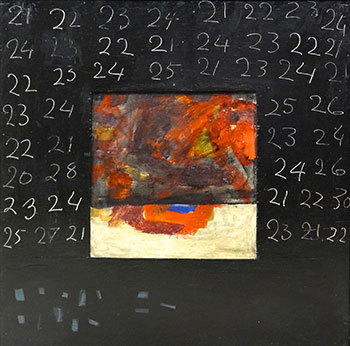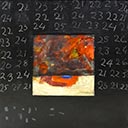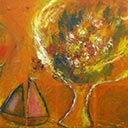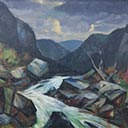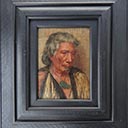Sangro Panel, 1962-63
51 x 51 cm
est. $25,000 - 35,000
Provenance
Dr Allan Godfrey Collection
Illustrated: p. 3 Ralph Hotere, Kriselle Baker & Vincent O'Sullivan, Ron Sang Publications 2012
Ralph Hotere's Sangro series was conceived as a memorial to the artist's older brother, Jack. The nine paintings comprising this series reflect a significant point of development in the artist's production: not only do they embody the dark politicisation which went on to characterise many of Hotere's later and most celebrated works, but they also convey a particularly piercing sense of personal pain and grief on the part of the artist, which transcends any more high minded artistic or philosophical concerns.
Private Jack Hotere and a number of his Maori Battalion comrades were killed whilst attempting to cross the Sangro River in pursuit of German forces in December 1943. Twenty years later, in 1963, Ralph visited the cemetery in Sangro where his brother lies buried alongside hundreds of fallen soldiers. This compelled him to create the series which would become the subject of one of the artist's first significant solo exhibitions, held at Barry Lett Gallery in 1965, in Auckland, Sangro Paintings and Human Rights.
This Sangro panel painting is an important example from the series. The work clearly delivers Hotere's raw and clear message of emotional clarity and grief.
The numbers inscribed across the surface appear almost as solitary headstones, each representing a fallen comrade of Jack's in that battle. In Hotere's own words, an expression of the utter futility of the wasteful destruction of the lives of young men, Each number represents the age of the fallen soldiers when they died. In their void-like existence which has been stripped of context, background, time and reference, the viewer is compelled to face the reality of these deaths in a very stark and confronting manner. Hotere has applied a reductive formalism to convey his own artistic message and sentiment.
Sadness is what permeates this work; an expression of familial mourning. Whilst the numbers in their striking contrast seem to pierce through the work, it is undoubtedly the blood-red, abstracted composition on card in the centre of the work which catches the viewer's eye. In the etymological sense, one is compelled to draw comparison between the Italian word "blood", sangue, and the work's reminder of the Sangro battle. In name and reality, the bloody and tragic humanity of this work and what it represents confronts the viewer.

